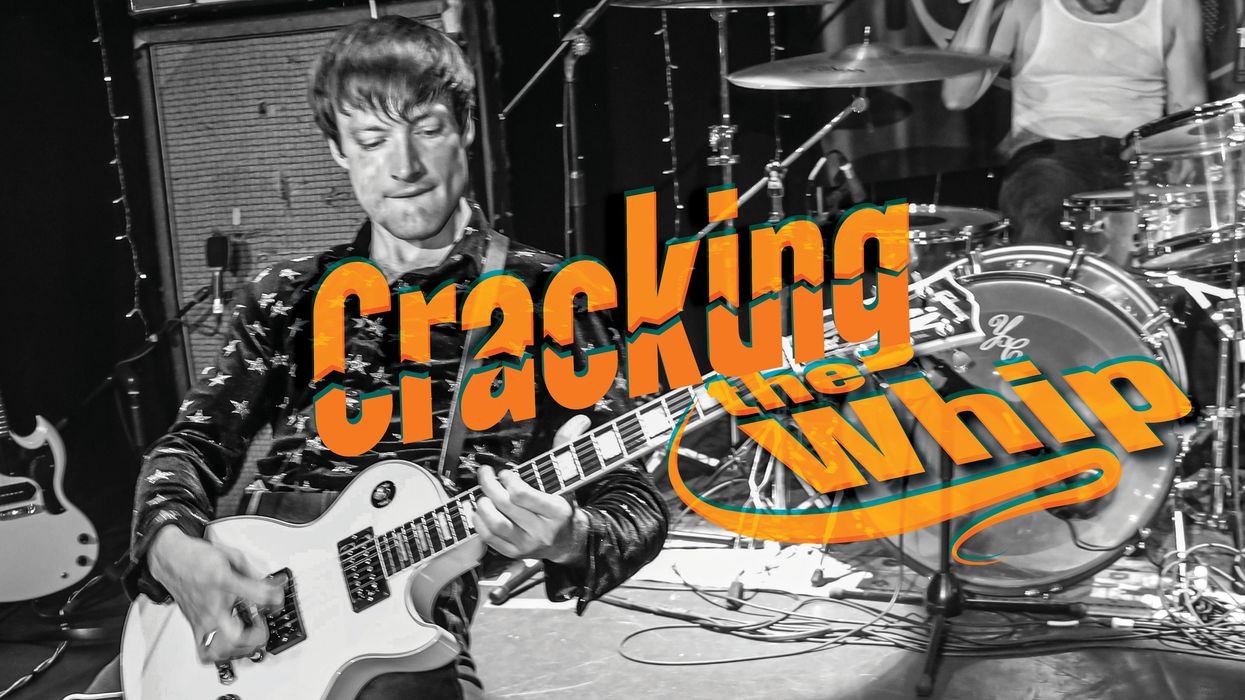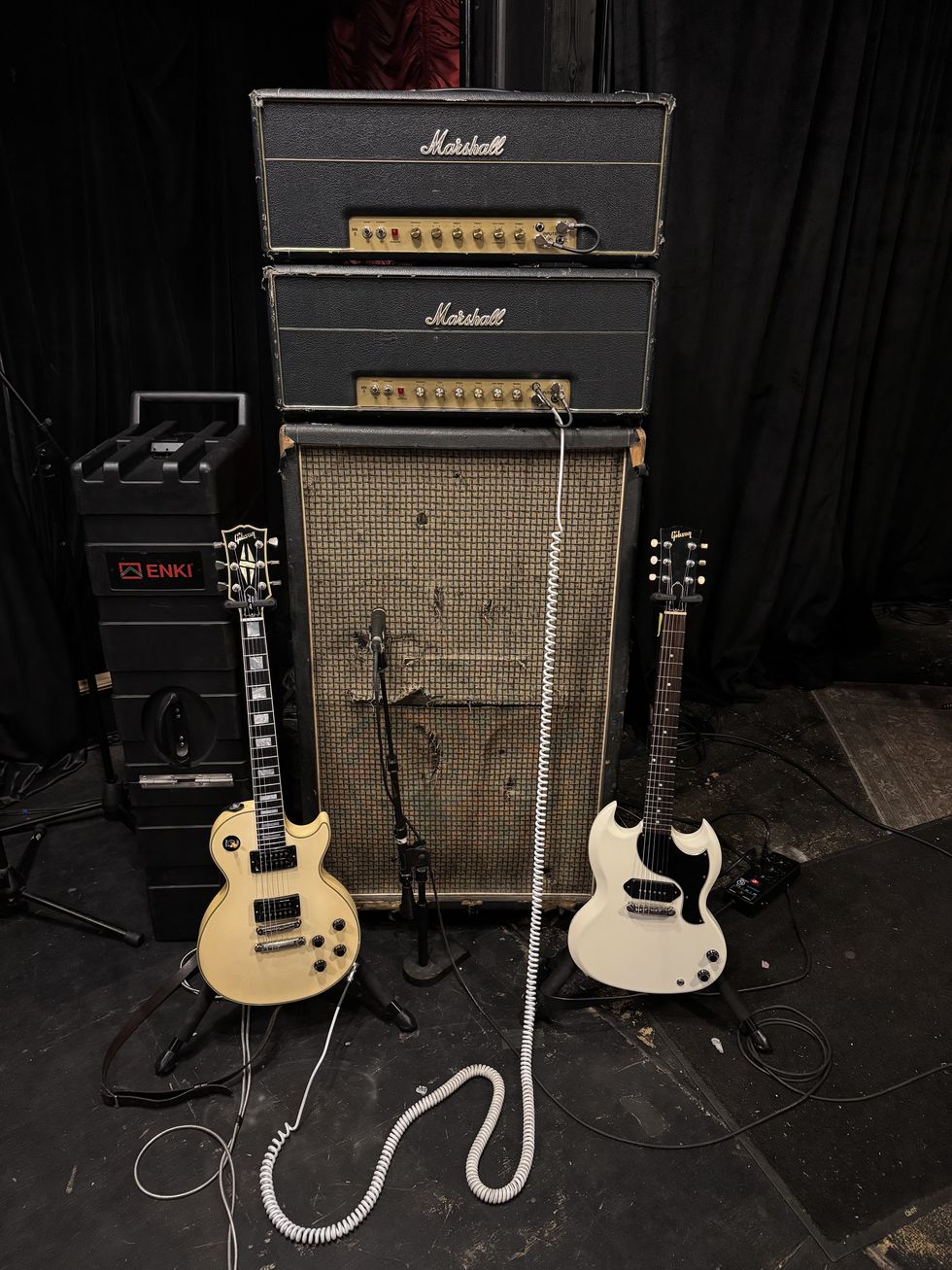“Form follows function,” explains Billy Corgan when asked about the evolution of his songwriting. These three words seem to serve as his creative dictum. “Early Pumpkins was more about playing in clubs and effecting a response from the live audience, because that’s where we could get attention."
When the Smashing Pumpkins formed in 1988, they were ripping in rock clubs with psychedelic-inspired sets that drew on ’60s-rock influences like Blue Cheer, Jimi Hendrix, and Led Zeppelin. But by 1992, after the breakout success of the previous year’s swirling alt-rock masterpiece, Gish, “Suddenly, we’re on a major label,” recalls Corgan. “Pearl Jam sold a gazillion records. Nirvana sold a gazillion records. Alice in Chains is selling a gazillion records. And somebody puts a finger up to my temple and says, ‘You better figure out how to write pop songs or you’re going to go back to working at a record store.’
“So, how do I translate this kind of hazy psychedelic vision into something that sounds like pop-rock radio? I’d better figure this out, and fast.” On 1993’s Siamese Dream, Corgan had obviously gone far beyond simply figuring out how to fit his vision into a radio-ready format; he’d pushed alternative rock to new heights, masterfully crafting hooks fit for the band’s unique, massive guitar-driven sound.
More than three decades later, Corgan hasn’t stopped evolving his artistry to fit the times. On the firm foundation of his extremely well-developed, instantly recognizable musical voice, he’s made his career one of the most interesting in rock music, branching out into unpredictable trajectories. In 2017, he launched a new career as a professional wrestling producer when he purchased the National Wrestling Alliance, the source of the limited TV series Billy Corgan’s Adventures in Carnyland.The Smashing Pumpkins - "Edin"
And he’s applied that knack for spectacle—a de facto pre-req for anyone in the pro wrestling biz—to the band’s social media presence. In January 2024, when guitarist Jeff Schroeder split with the Smashing Pumpkins, they turned to the internet for an open call. Not only did the band eventually find new-hire Kiki Wong, but they effectively got every guitarist on the internet dreaming about joining the Pumpkins.
Corgan has also found a creative outlet as a guitar conceptualist. His four signature Reverends—the Billy Corgan Signature, Terz, Z-One, and Drop Z—were created in collaboration with Joe Naylor, the company’s visionary builder. Taken together, these models go well beyond standard signature artist instruments protocols. Not content to just design his own dream guitar, Corgan is equally concerned with contributing to the guitar community. The Billy Corgan Signature and Z-One models are forward-thinking electric guitars well-outfitted with hip, futuristic aesthetics and custom pickups; the Terz and Drop Z break new ground in guitar design. The Terz is a 21 1/2"-scale model meant to be tuned one and a half steps up—G to G—and the Drop Z model, at 26 1/2" scale, is intended for D standard or lower tunings. In the case of these alt-tuned guitars, the instruments are specifically voiced for their tunings, with custom pickups.
“In that quiet solitude of just you and the guitar, this communication can happen that sort of expresses something about yourself that is surprising.”
With all this action—plus signature Yamaha acoustics and his Highland Park, Illinois, café, Madame Zuzu’s, which he owns with his wife, Chloé Mendel—Corgan must be dialing into a deep, super-focused state when working on music, because he’s been prolific. In 2023, the Pumpkins released the epic ATUM: A Rock Opera in Three Acts, the third part of the trilogy that began with the Pumpkins’ smash-hit Mellon Collie and the Infinite Sadness in 1995, followed by 2000’s Machina/The Machines of God. In 2024, the band released Aghori Mhori Mei. Pitched as a stripped-down guitar record, and exempt from the former’s grandiosity, the songs are often riff-centric guitar jams, full of dark, in-your-face tones. But that pitch might belie the album’s rich compositional complexity and intense emotional breadth. Corgan’s writing on Aghori exemplifies all the nuance and finesse of his broader work, as do the dynamic, thoughtful guitar arrangements and hard-hitting performances.
With so much going on, how does Corgan keep his artistic vision focused and in step with the times? How does he find time to tap into the creative essence that has made his music so special? What drives his process? The only way to find out is from Corgan himself.
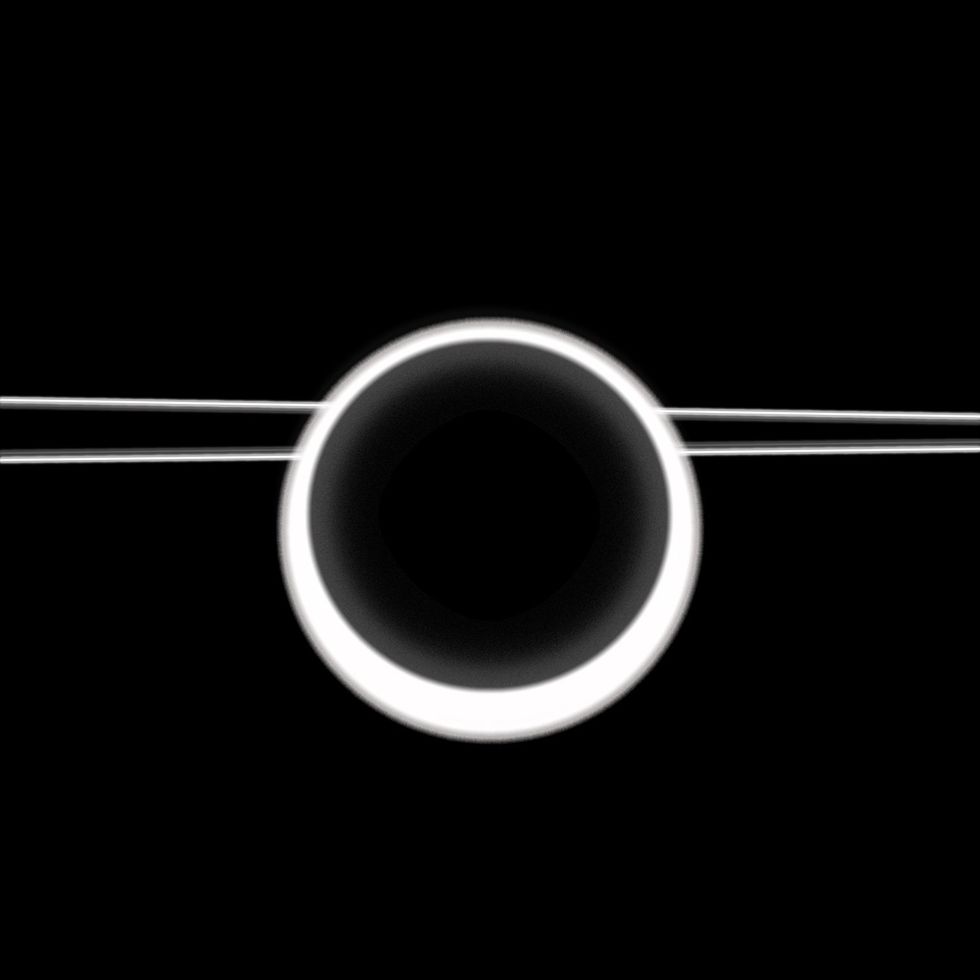
The Smashing Pumpkins’ Aghori Mhori Mei was pitched as a more stripped-down guitar record, but don’t let that description, fitting as it may be in comparison with their recent work, belie its majesty.
The premise of Aghori was to be more of a stripped-down guitar record. How did you approach this album from a compositional perspective?
Corgan: The idea was to return to the early language of the band and see if it had a modern application. If you were making a movie, it would be akin to: We’re going to shoot this on VHS cameras and edit in an old analog bay and see if you can make something that a modern audience would actually enjoy and appreciate.
The way most rock records are made these days is “in the box,” which is Pro Tools or whatever people use. You can hear that the digital technology is very important to the way modern rock music, whether it’s metal or alternative, is made. It’s become the fifth band member—you know what I’m saying? They’re able to do things and effect changes and musically innovate in a way that you wouldn’t if you were just on a floor with the band playing in a circle, like we used to. So, for us, we could continue down this digital path, and I’m not that interested in gridding out my guitars.
When you go listen to a Pumpkins record, that’s live playing. That’s not all chopped up—99% of what you hear is literally from our hands and mouths—we’ll still fly in a chorus here and there. If you’re at a particular crossroads, do you continue to move forward and with technology as your ally? Or do you kind of go back and see if that old way still has something magical about it? That becomes sort of the existential debate of the record, both internally and publicly, which is: Is there a there, there?
But to clarify, this isn’t an analog recording.
Corgan: We record to Pro Tools. It’s using the technology of Pro Tools to make your records that we don’t do. I’m not trying to make a point. I’m saying using the technologies that are present to write your music or using it to do things that you can’t humanly do—that we don’t do.
Listen to your standard metal record. Everything is gridded to fuck: All the amps are in the box, all the drums are in the box, there’s not a missed note, everything’s tuned to fuck. You know what I mean? That’s modern metal, and I like it. It’s not like I turn up my nose at the thing, but that’s a way of making music for many people in 2024. We decided to try and go back and make a record the old-fashioned way, not to make some sort of analog point.
“There’s a certain loneliness in the way I play because I didn’t have anybody else to play guitar with.”
You write mostly on acoustic and piano. Where do the guitar arrangements come in?
Corgan: The fundamental process, going back to the beginning, is to create the basic track; the vocal then becomes the next most important thing, and then the icing on the cake is the guitar work over the top of that, basically to support and supplement the vocal and create more melodic interaction.
I got a lot of that from Queen and Boston and some Beatles—the idea that the guitar takes on a lead voice of its own that’s distinctive and almost becomes another lead singer in the band.
That stuff doesn’t show up literally until the last day working on the song. It’ll come off wrong, but we don’t spend a ton of time on it. And I don’t know what that means other than it seems to be like everything is done, and then you go, “Okay, time for the guitar work.” You’ll spend three hours, six hours just going through and trying stuff. Then it sort of just appears, and you go, “Oh, that sounds cool,” and you move on. It benefits from being fresh or feeling kind of like an emotional reaction.
I remember being in a car circa 1975 or ’76 and “Killer Queen” by Queen was on the radio. You’re listening to a song, the song sounds cool, and there’s flange vocals, and I’m 10 years old, in the backseat. All of a sudden, that lead break comes in; it’s just fucking loud. It has that feeling of somebody stepping forward into a spotlight. It’s not a show-off thing. It’s the way it makes you feel. It’s like a lighter type of moment. We’ve always chased that feeling.
Billy Corgan's Gear

Corgan with his signature Yamaha LJ16BC in 2022.
Photo by Mike White
Guitars
- E standard: Billy Corgan Signature Reverend Z-One Black
- E backup: Billy Corgan Signature Reverend - Satin Purple Burst
- Eb standard: Billy Corgan Signature Reverend Z-One - Silver Freeze
- Eb backup: Billy Corgan Signature Reverend Z-One - Orchard Pink
- Eb standard: ’70s Gibson ES-335 walnut
- C# standard: Billy Corgan Signature Reverend Drop Z - Pearl White
- Prototype Gibson Firebird
- Billy Corgan Custom Signature Yamaha LJ16BC Black with Silver Star
- Billy Corgan Custom Signature Yamaha White with Black Star
Amps
- Ampete 444 Amplifier & Cabinet Switching System
- Korg DT-1 Rack Tuner
- Carstens Cathedral
- Orange Rockerverb MkIII
- Carstens Grace Billy Corgan Signature Head
- Laney Supergroup LA100SM
- Laney LA412 4x12 Black Country Custom
Pedals
- RJM Mastermind GT/22 MIDI Controller
- Lehle D.Loop
- Warm Audio Warmdrive
- MXR Phase 90
- Catalinbread Zero Point Tape Flanger
- Behringer Octave Divider
- Strymon Brigadier dBucket Delay
- EarthQuaker Devices Time Shadows II
- Custom Audio Electronics MC-403 power supply
Strings
- Ernie Ball Regular Slinky (.010–.046)
- Ernie Ball Power Slinky (.011–.048)
- Ernie Ball Not Even Slinky (.012–.052)
- Ernie Ball Earthwood Medium Light (.012–.054)
Guitar starts out for so many of us as this really personal thing that we spend all our time doing, and then as life gets more complicated, you just have less time. What is your relationship with the guitar like in 2024? Do you have a day-to-day relationship with guitar playing?
Corgan: I do not. I don’t really pick up the guitar much unless I’m working.
When you do pick up the guitar, is it with intent? Do the ideas come inspired by the guitar, inspired by something you play? Or are they up in your head, and then you’re grabbing a guitar to realize it?
Corgan: If I pick up a guitar, I’m looking to play something that surprises me. It’s whatever comes out. And sometimes you hit the wrong chord and go, “Oh, that’s interesting.” Or you find a new inversion or something that you never thought of before. You try to play a different scale run than you’ve played 10,000 times, always landing on the same note. It’s just looking for something just a little bit new. I find oftentimes, in that quiet solitude of just you and the guitar, this communication can happen that sort of expresses something about yourself that is surprising—an emotional feeling or a way of approach.
“You could say to me, ‘Hey, play me some Siamese-type thing that you would’ve done in ’92,’ and in five minutes, I could write you something that would sound like a song that would’ve been a Siamese song in ’92.”
The style of my guitar playing came out of taking care of my disabled brother when I was a teenager, so I was stuck inside a lot. To paint a simple visual, imagine being stuck inside on a summer’s day and watching people play outside through the window as you’re playing the guitar. That was my life for much of my teenage years, because I was in this position where I had to look after somebody who was not so much homebound, but it wasn’t like the type of child at his stage of development that you could take him in the backyard and let him run around. You kind of had to look after him. It often became easier to stick him in front of a television or let him take a nap while you’re practicing.
There’s a certain loneliness in the way I play because I didn’t have anybody else to play guitar with. I developed a style that had a kind of call-and-response aspect to it in the open strings and the drone playing, because it was a way to effect a larger conversation without somebody else in the room.
Then, when it was James [Iha] and I in the early days of the band, James would basically do different versions of what I was playing. That created an even bigger conversation that seemed to create almost like a third guitarist. You can hear that in the whistling harmonics in the background. That’s just two guitars playing, but you create a ghost effect. I’ve done a lot of guitar work in the studio where people would be visiting me, and they look at the speakers, “What’s that sound?” And I’m like, “That’s just two guitars.” They don’t believe me. I literally have to solo the two guitars and just show them. That’s the harmonic effect.
I still have that inner relationship with my playing, where I could just sit down and play and find something that sounds like a bit of a conversation.
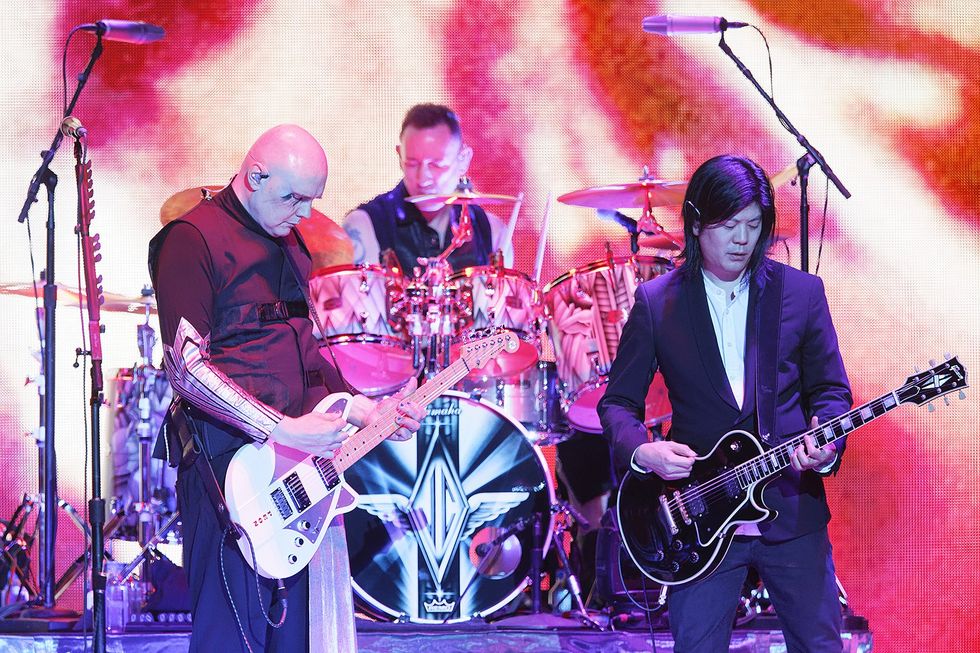
The Reverend Billy Corgan Signature in the hands of the man himself alongside drummer Jimmy Chamberlin and guitarist James Iha.
Photo by Ken Settle
When you’re writing, picking up a guitar, looking for those things, like you said, are you still after the same feeling you had initially or has the feeling changed?
Corgan: I think it’s more trying to find something that seems to signify whatever’s happening at the moment. It’s a truthfulness. You could say to me, “Hey, play me some Siamese-type thing that you would’ve done in ’92,” and in five minutes, I could write you something that would sound like a song that would’ve been a Siamese song in ’92. I can dial in any era of the band or my writing at will, because they’re all based on methodologies and certain emotional templates. So, I’m trying to do that for today. What is the 2024 version of that that makes me feel something—anything at all?
There’s this other creative side to your work, which is your signature gear. You have four Reverend guitars, and they’re all very different from each other. You’ve created them with Joe Naylor. Can you tell me about that collaboration?
Corgan: Somehow, Joe is able to go back and listen to what I’m referencing, and then translate that into something that’s physically tangible and consistent.
I don’t think a gimmicky guitar serves anybody. My signature guitars need to be useful to anybody else doing their music, not just my kind of music. And I’m very proud of that. I think that’s what makes a great guitar—it has application to whoever picks it up. And a lot of credit to Reverend to be willing to take these chances that I’ve sort of set them off chasing.

The Reverend Billy Corgan Drop Z is specially voiced in feel and sound for D standard and lower tunings.
They’re all bold guitars, but especially the Terz and the Drop Z, which are built specifically for alternate tunings. What were you looking for when you came up with the idea of those instruments?
Corgan: The thing with the Terz, which is G to G as opposed to E to E—a step and a half higher—was in listening to guitarists like Jonny Greenwood of Radiohead and other guitar players of that generation, I noticed that the function of the guitar for many alternative guitar players was becoming more atmospheric and less elemental. I thought maybe they would like to have a higher tonal range to work in. Because, ultimately, in 2024 logic, you want to get the guitar away from the vocal. If you think of the classic Telecaster sound, well, if you’re playing in the key of G on a Telecaster, that sits exactly where the vocal is. It’s like the worst possible place for a guitar in the 21st century. But if you can increase the harmonic range of the guitar, it does sort of sit, elementally, a little higher.
I don’t think people have figured that out yet about that guitar. But I have a funny feeling that at some point somebody will, much like when Korn took the Steve Vai guitar and took it in a completely different direction and made a whole new genre of music with it. I think the Terz opens a player up to a different tonal range.
“I don’t think a gimmicky guitar serves anybody. My signature guitars need to be useful to anybody else doing their music, not just my kind of music.”
A lot of these modern alternative guitar players, they don’t play super complicated stuff. Whether they were inspired by Jonny from Radiohead or the guy from Coldplay, it’s more like a tweedle-y guitar, like twilight, vibey.... You look at their pedalboards; it’s a lot of reverbs and bucket delays and stuff like that. I get it.
On the Drop—on making Aghori, I found myself thinking a lot about Mick Mars’s guitar sound and where Mick’s guitar sat in Mötley Crüe. Early Mötley Crüe was basically a guitar tuned down a step. Something about the D range—you could do it on a normal guitar, but it gets a little sloppy with the tuning and certainly the intonation. So, I talked to Reverend about making a D-to-D guitar that doesn’t feel like a baritone guitar, that plays and feels very much like an E-to-E guitar, but gives you range. For a modern guitar player who wants to make music that ends up on the radio, the specificities of where that guitar needs to sit tonally and how it would be mixed is what I was thinking of.
So, these are instruments for the modern player who wants to make music that can reach people vis-à-vis what is the media these days—streaming or whatever. If you want to take an old guitar and tune it down to F and all that … I did all that crazy stuff, too. I wouldn’t discourage anybody from doing it. But these are specific instruments with a very specific purpose, primarily for recording.
On “Edin” [from Aghori Mhori Mei], well, that’s that guitar. I think in that song, it’s dropped, so the low string is a C. But you can hear how that guitar sits so forward in the track. That’s a credit to Joe making that guitar exactly what I wanted, and the pickups really doing their job with how it sits in the track.
Corgan has an early memory of hearing Brian May’s lead break on “Killer Queen”: “It has that feeling of somebody stepping forward into a spotlight. It’s not a show-off thing. It’s the way it makes you feel. It’s like a lighter type of moment. We’ve always chased that feeling.”
Photo by Corrine Luxon
I want to come back to how that affects your playing. You have these instruments that are now specifically voiced to your vision. When they get in your hands and you’re working on something, how do you exploit the sonics of those guitars? Maybe you wrote a song on acoustic, but now you have this instrument that you’ve helped ideate, and you can do stuff that your other guitars can’t. Where does that come in the creative process?
Corgan: I don’t think I have a romantic answer. For me, it’s more about recording accuracy or clarity. If you compare, let’s call it the “Mellon Collie ’95” guitar sound, where we were mostly a half-step down; it’s clear, but it’s very sludgy—a lot of midrange and not a lot of stuff above, say, 17k, because I was using those Lace Sensor pickups. Modern recording; everybody wants the guitar as far forward as you can get it.
These days, I’m mostly using these Carstens amps, which is a Chicago amp-maker, Brian Carstens. I used one amp that he made for me, the Grace, which he does sell, which is kind of a modern take on the Eddie Van Halen brown sound—a ton of gain, but clear. And then he has another amp called Empire, which is more for a metal player. I use that as well. And in some cases, I stack both amps on top of each other by reamping. He has another amp, called Cathedral, which is like a cross between a Fender Twin and a Hiwatt. Again, very clear.
“Modern recording; everybody wants the guitar as far forward as you can get it.”
The best way I can explain it, and this is my poor language-ing, but if I was to take a vintage Marshall plexi and a Les Paul, like a classic amazing guitar sound, and record the riff for “Edin,” and then I was to take my Reverend Drop Z run through a Carstens amp, and you listen to the two tracks, the modern stuff I’m using, the guitar is like six more feet forward in the track; the vintage stuff sounds kind of back there. You can hear it—a little gauzy, a little dark, and the modern stuff is right in your grill. It’s not harsh; it’s not overly midrange-y. It just sounds really good and present.
So that’s the key. Because I play so distinctively that I kind of sound like me whatever you put me through, my focus is more tonal and how it sits in the stereo field.
Are pedals just pragmatic means to achieve a tone? Or is there exploration involved there?
Corgan: Since Siamese Dream, where we famously used the op-amp Big Muff and EHX Micro Synth, and some MXR stuff, the main sound of the band is just crank through something. Going back to something my father told me many, many moons ago: guitar, chord, amp is the key. I worked in the studio with Tony Iommi. Those hands, a chord, an amp—and when he plays, God’s moving mountains. We get super granular when I’m in the studio; I might play a chord that’s no more than seven-feet long, anything so I can be as close to the amp as possible, so there’s the least amount of chord from the guitar to the amp.
It’s all about driving the amp and moving that air and moving those electrons in the tubes. That’s just the key for me. If there’s pedal work on any Pumpkins albums in the last 25 years, it’s for solos and little dinky things on the top. The main guitar sound is always pure power. We want as much pure power as possible.
YouTube It
The Smashing Pumpkins kick out “Sighommi” from Aghori Mhori Mei live on Kimmel with new-hire Kiki Wong joining Corgan and James Iha in the guitar section.
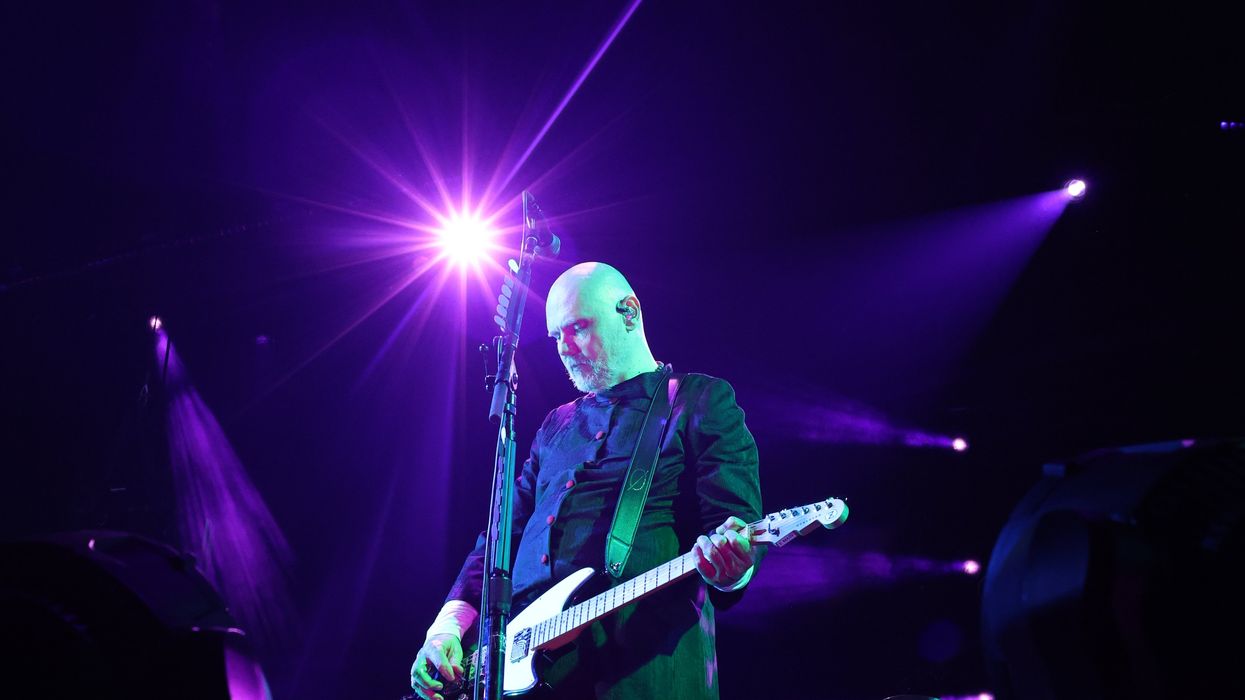

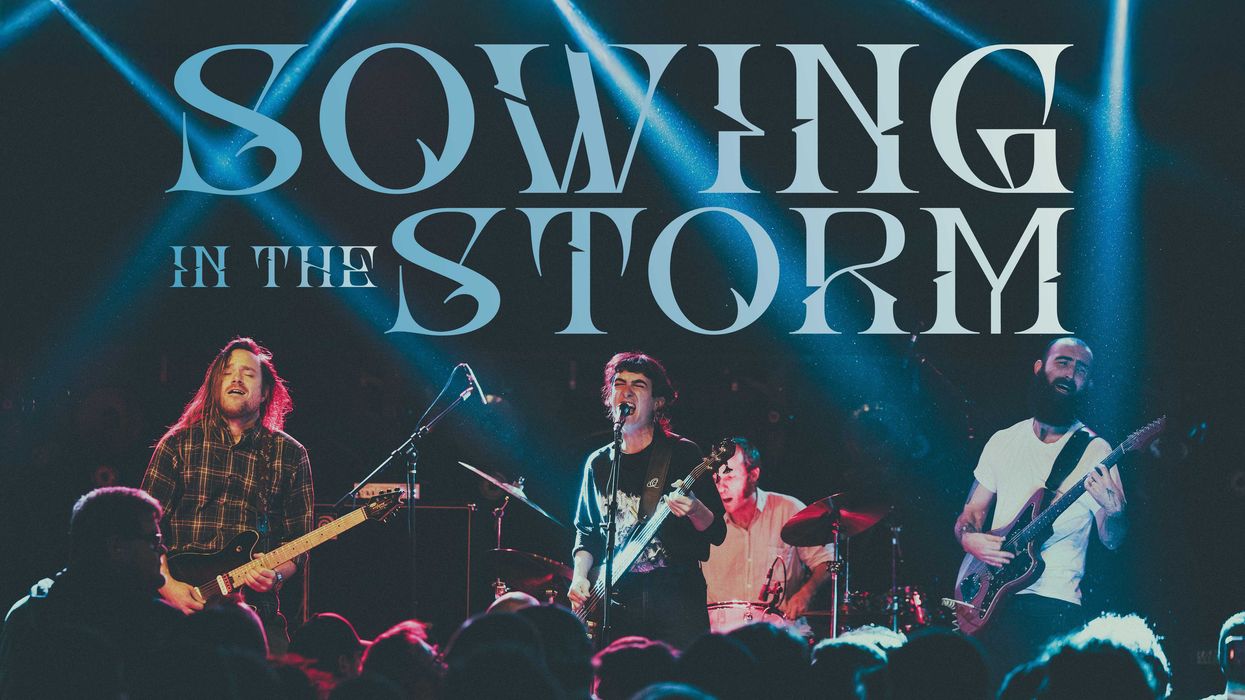
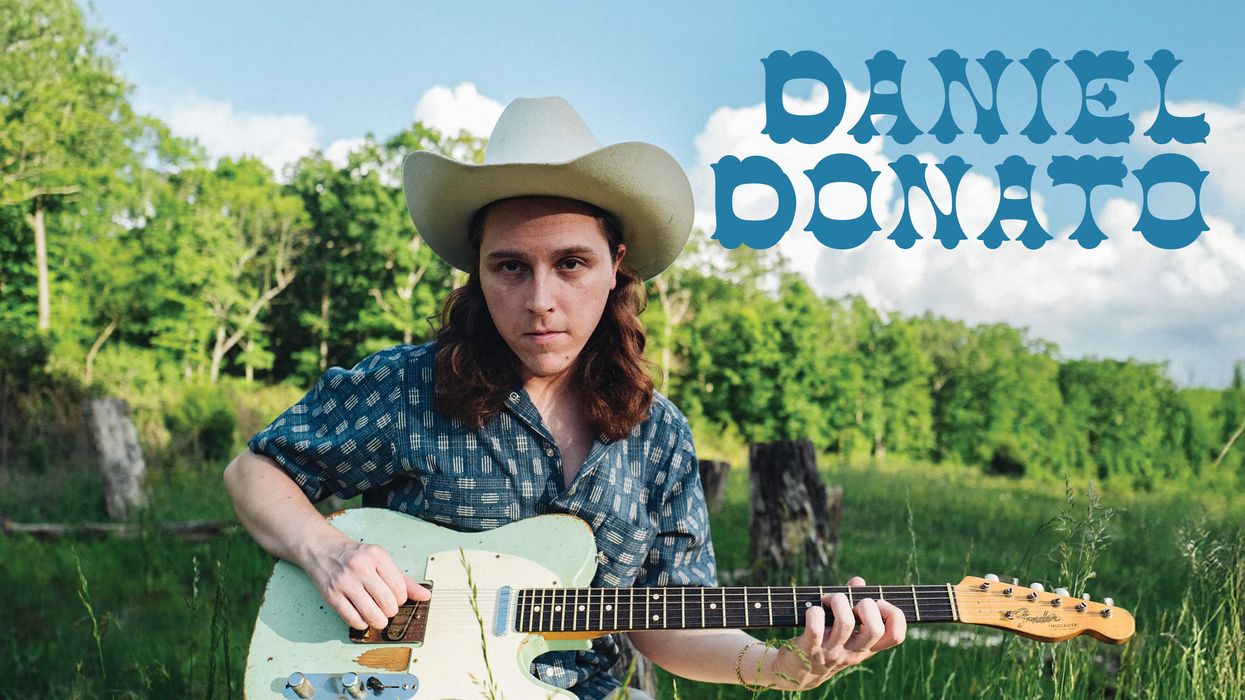
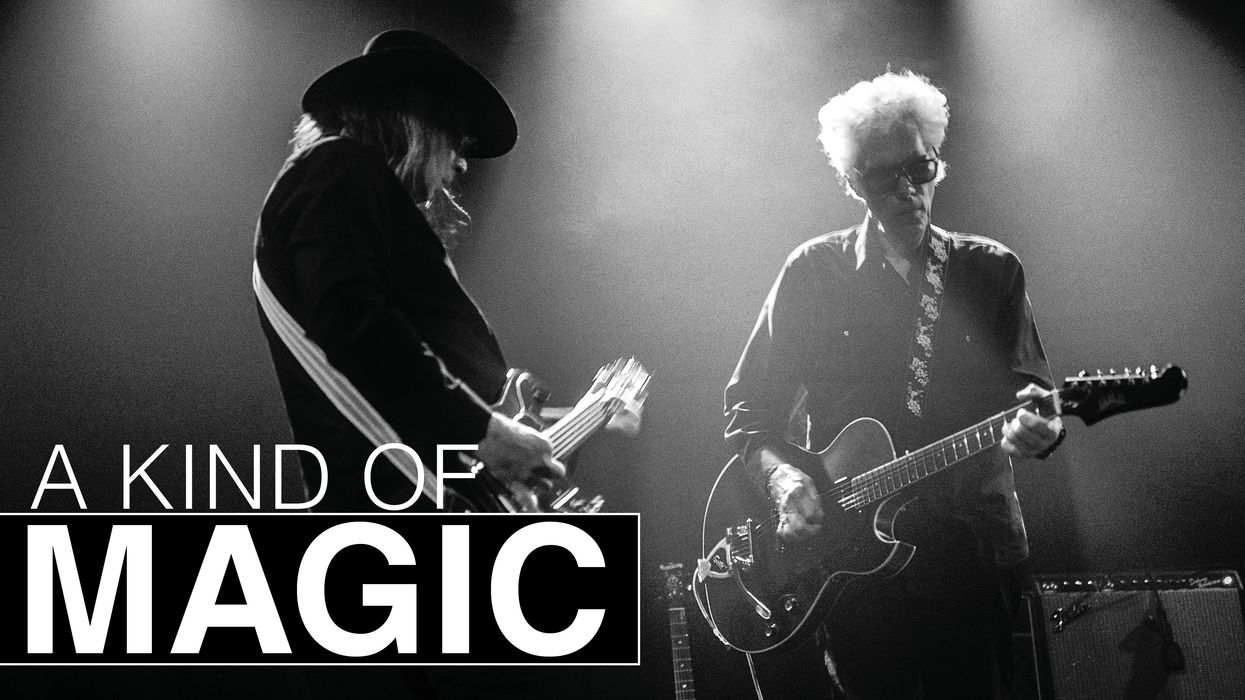
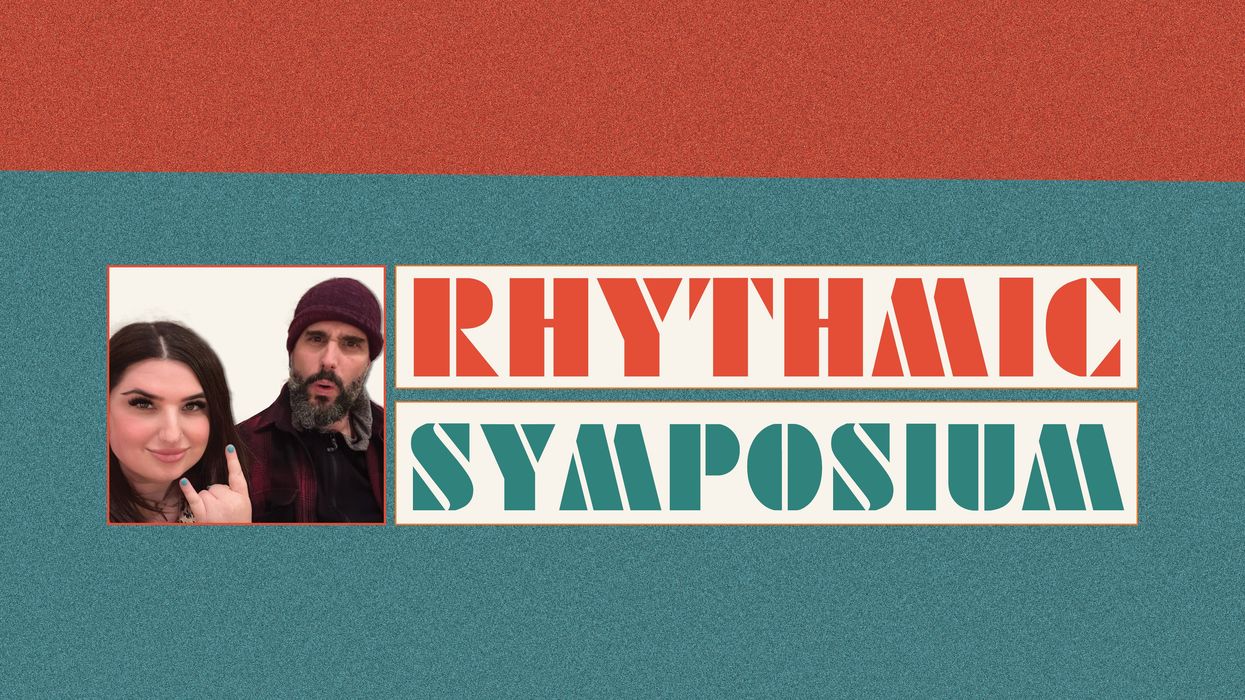










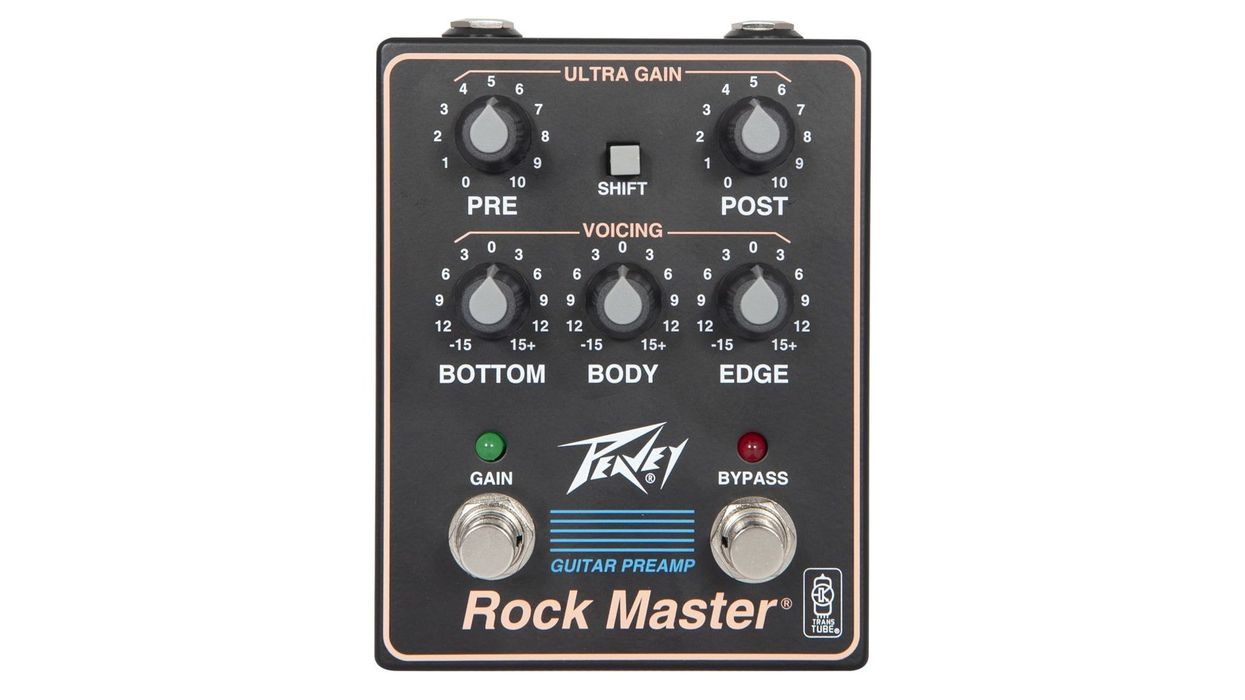
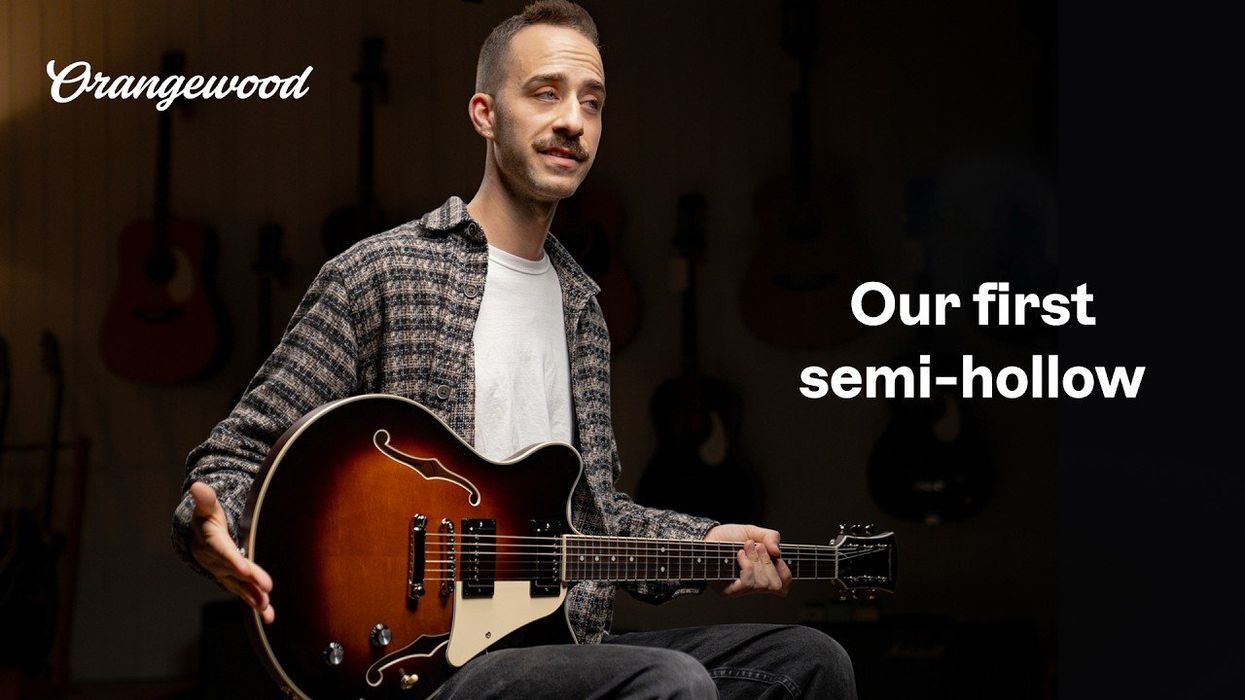
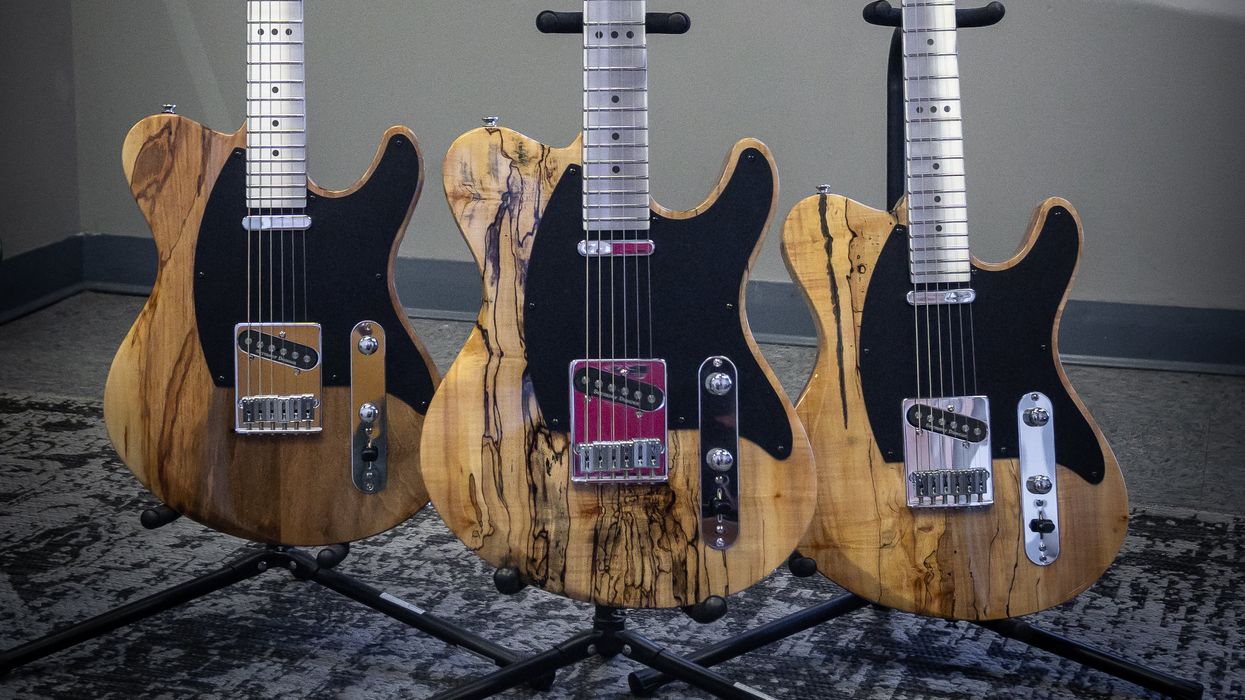

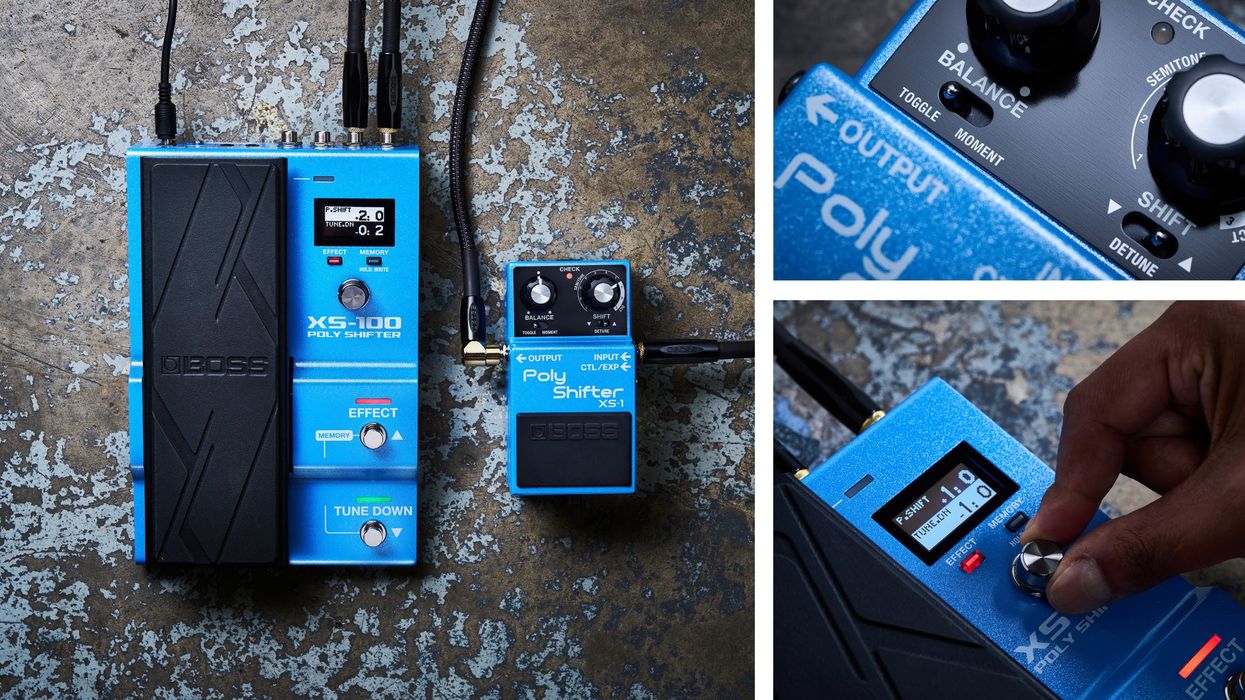









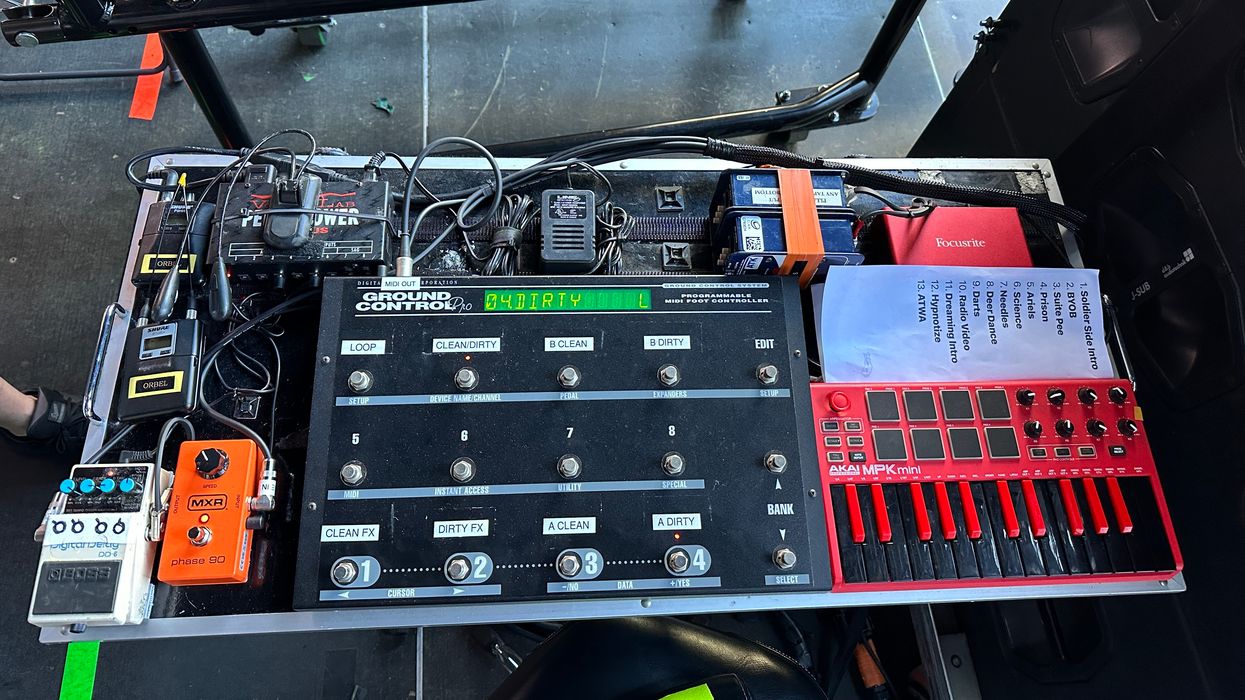

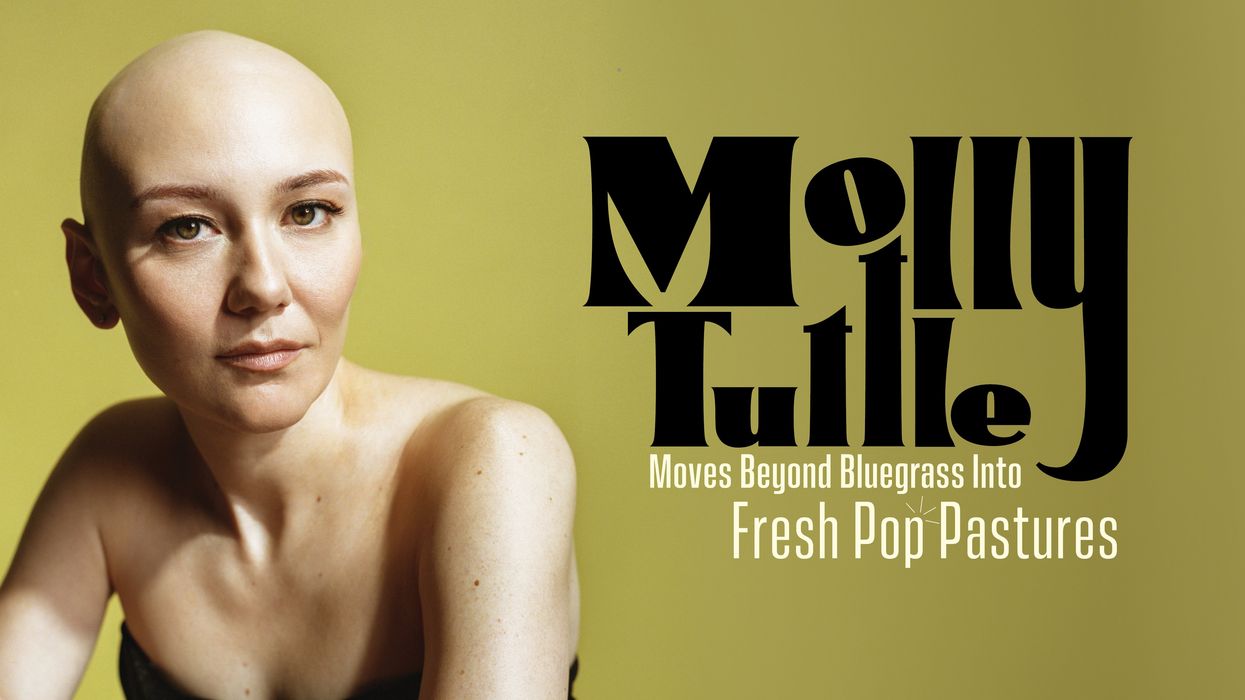

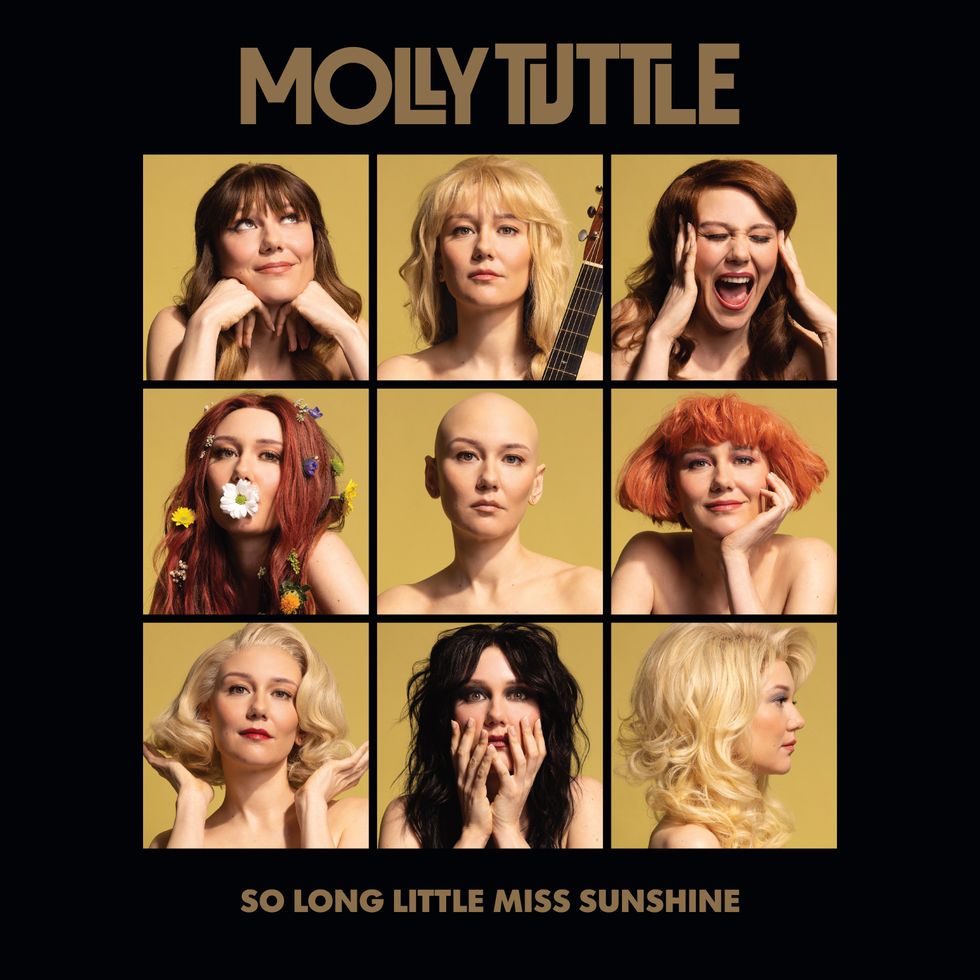
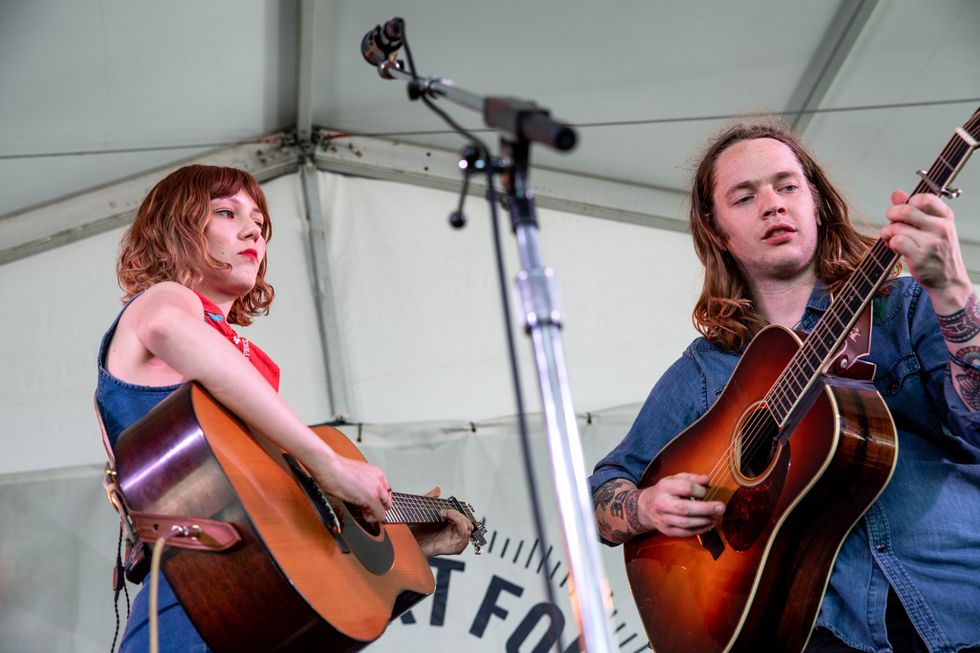
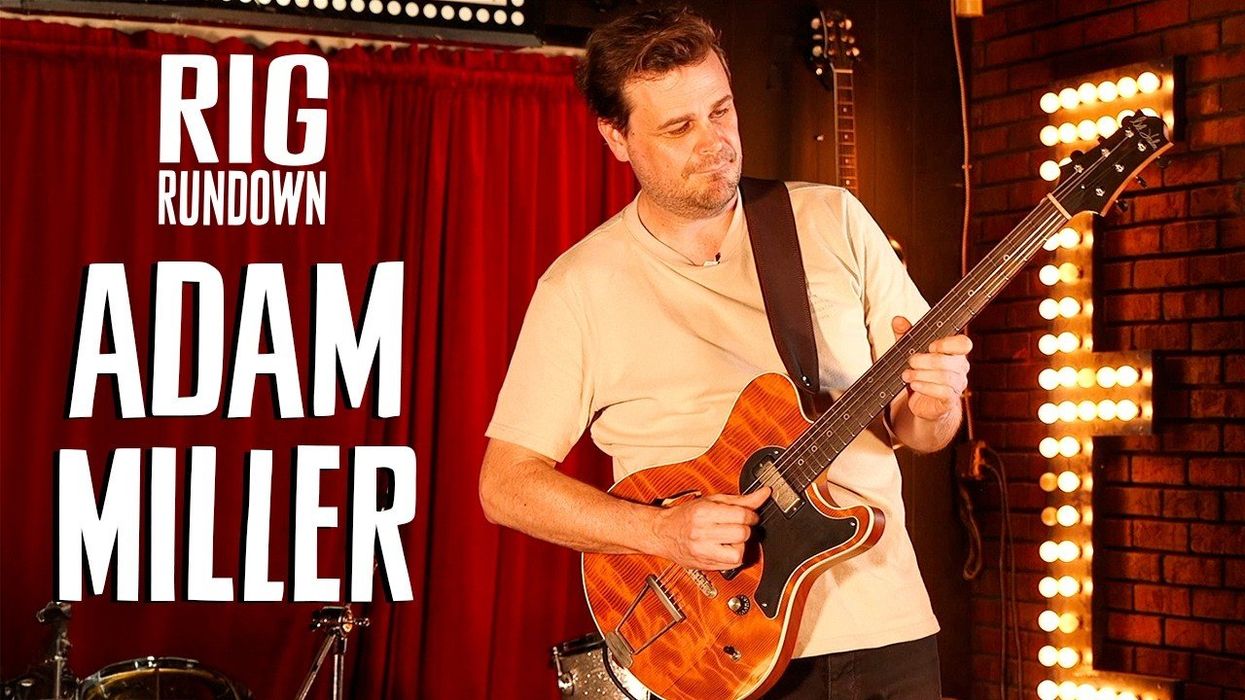
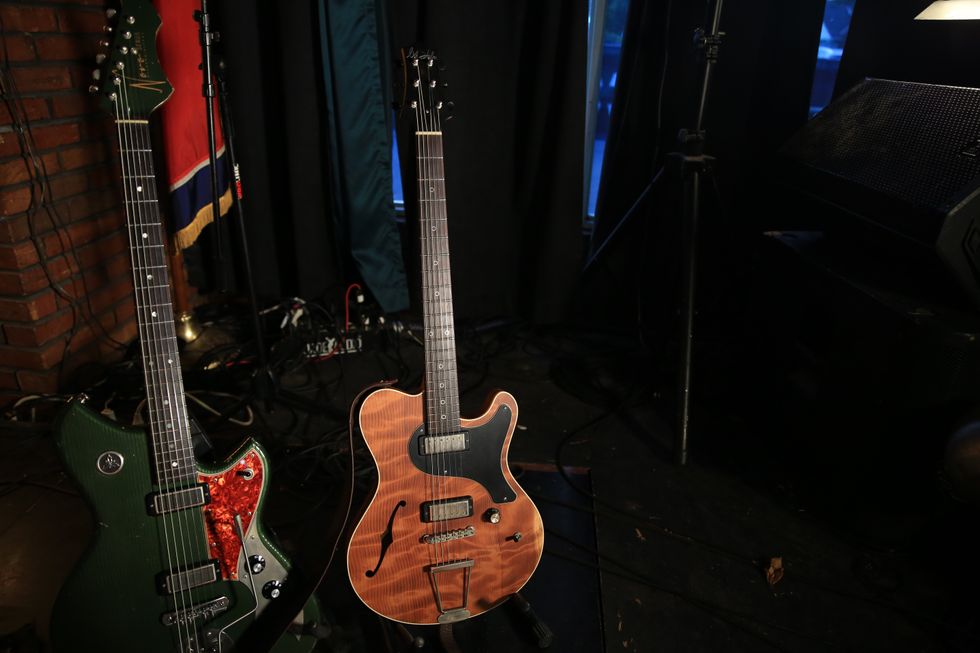
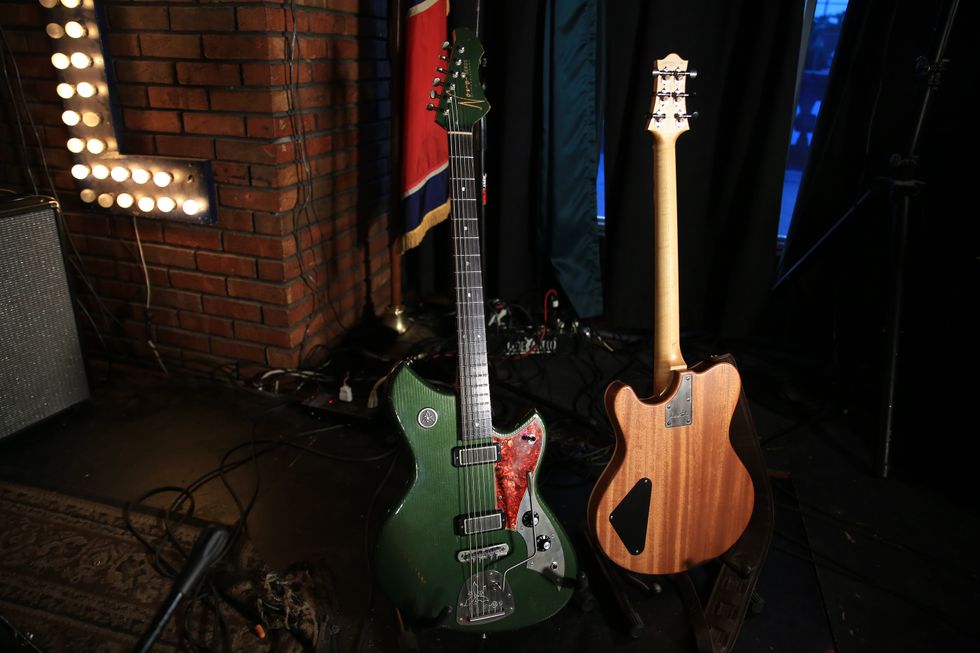
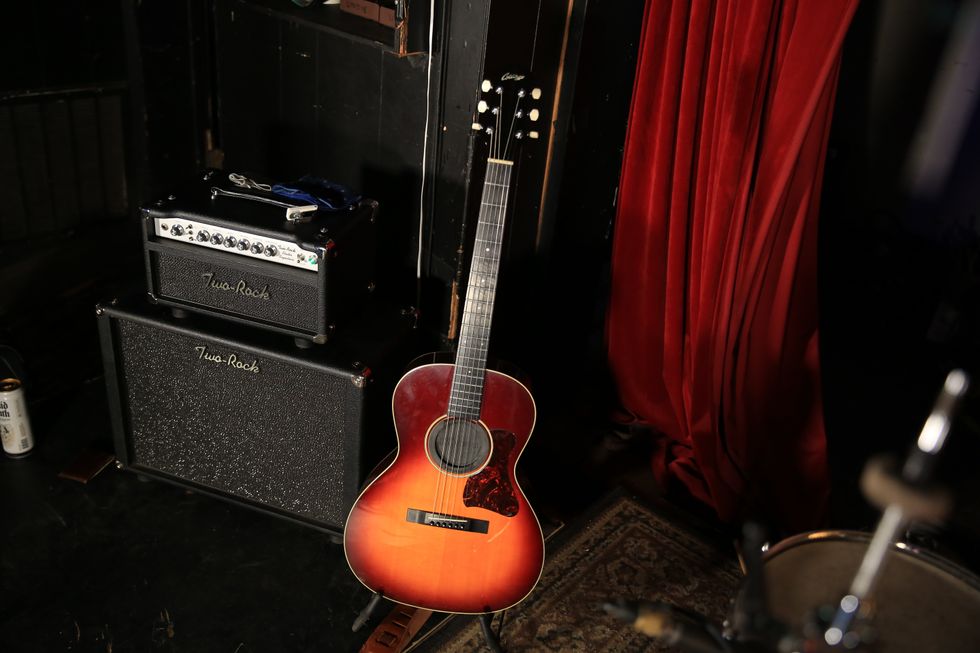
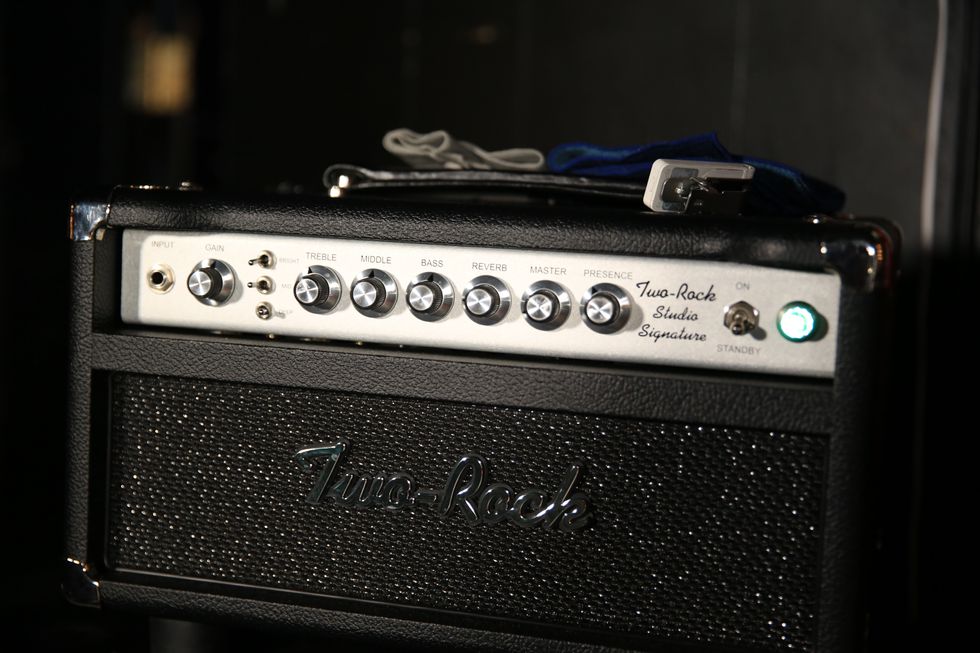
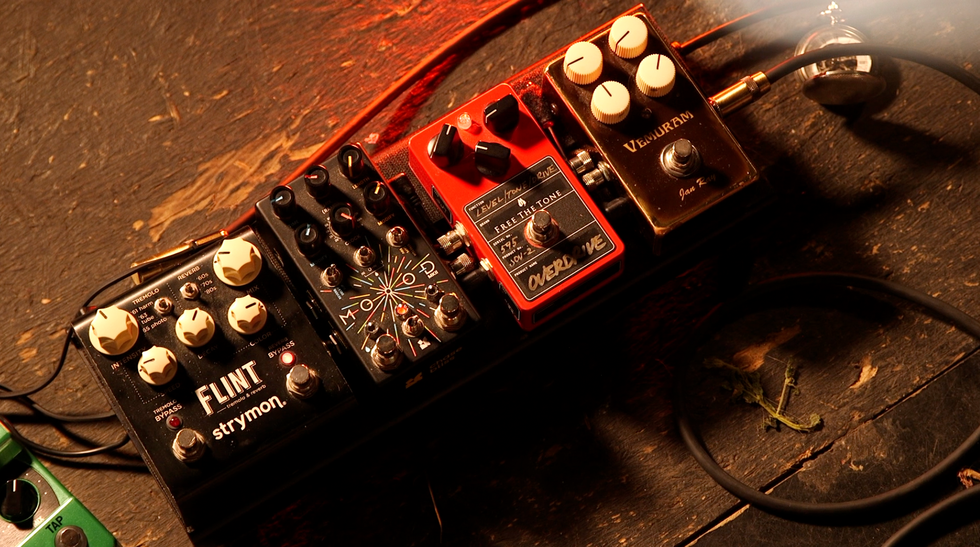
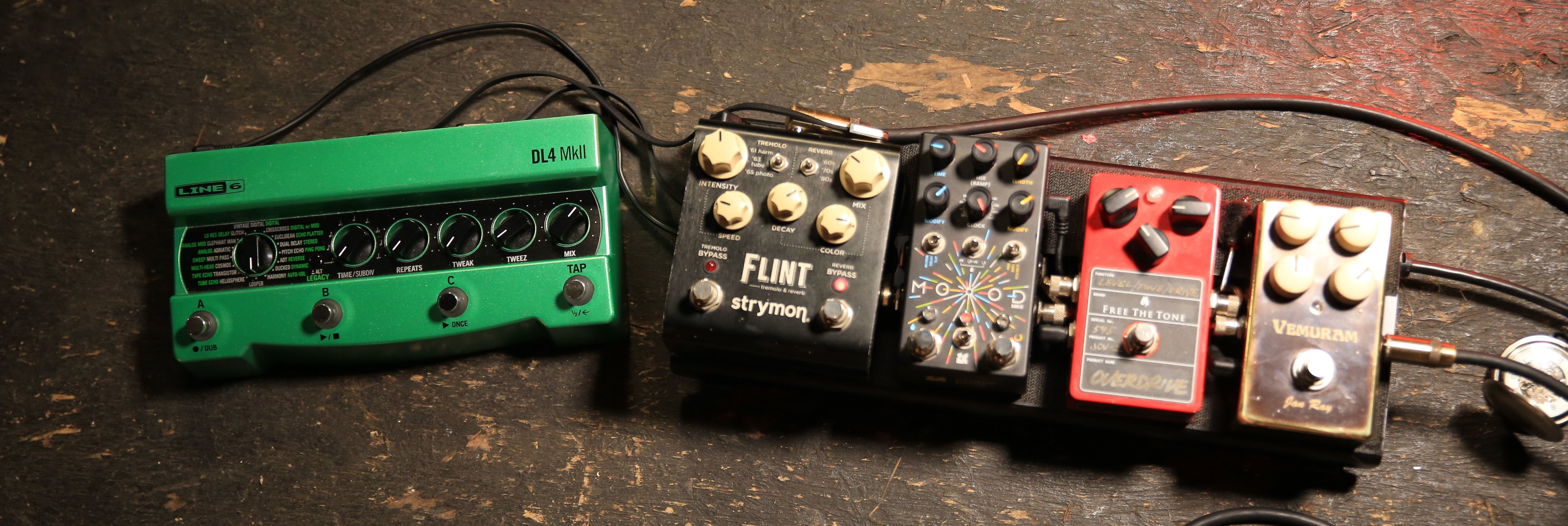 Miller’s Collings runs into a Grace Design ALiX preamp, which helps him fine-tune his EQ and level out pickups with varying output when he switches instruments. For reverb, sometimes he’ll tap the
Miller’s Collings runs into a Grace Design ALiX preamp, which helps him fine-tune his EQ and level out pickups with varying output when he switches instruments. For reverb, sometimes he’ll tap the 